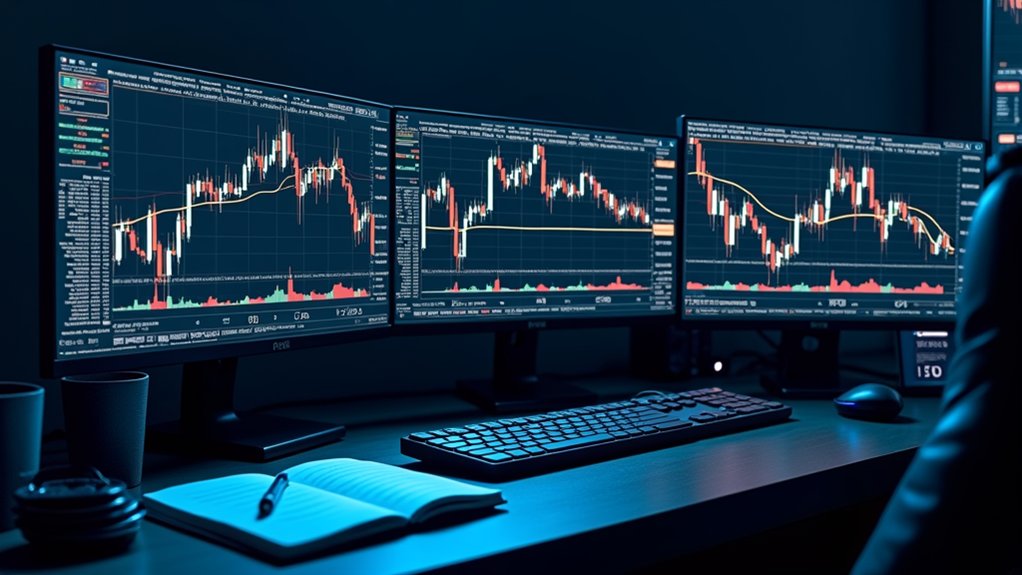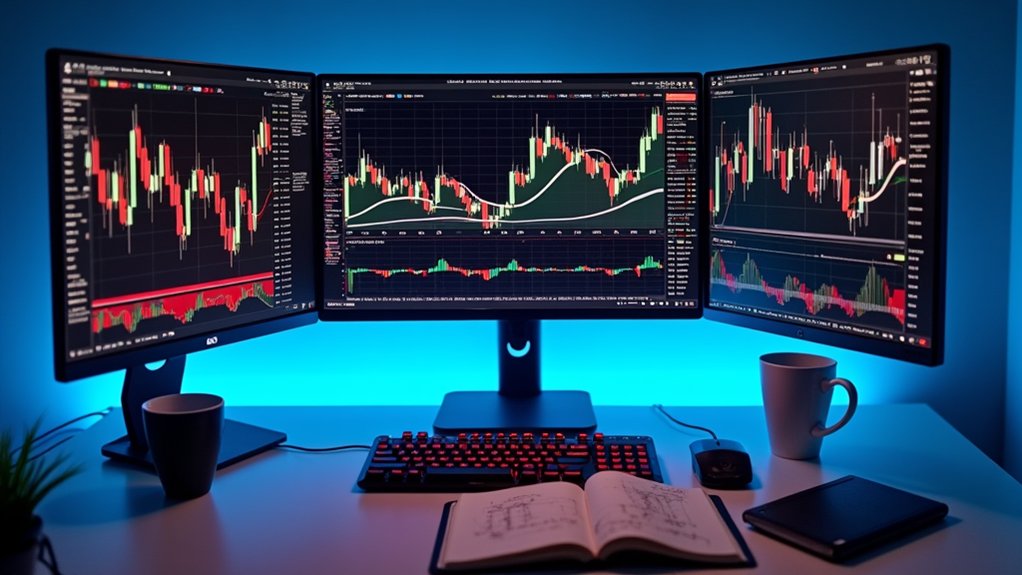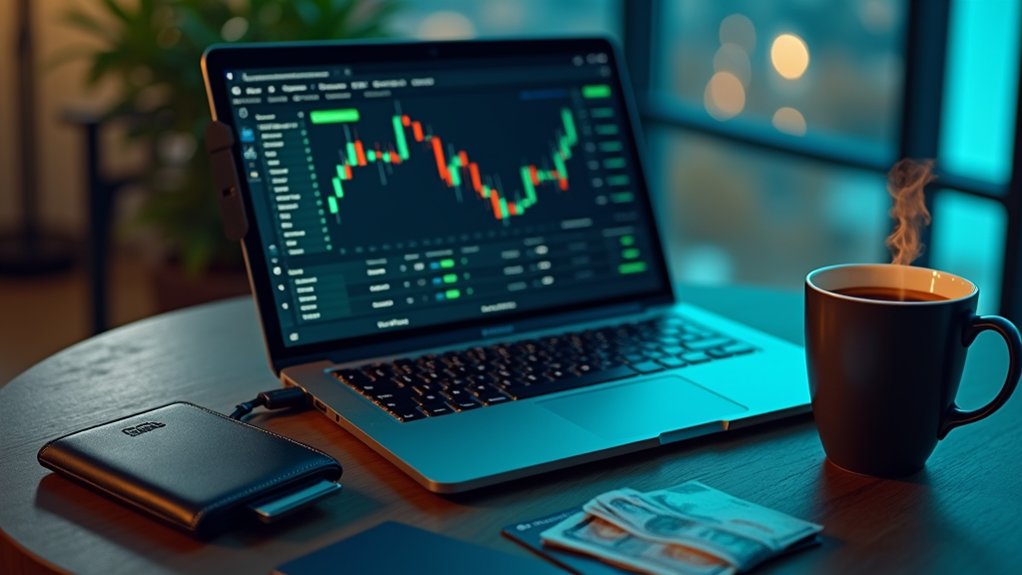Short-term crypto trading utilizes technical analysis tools including moving averages, Bollinger Bands, and candlestick patterns to capture rapid market movements. Day traders focus on 15-minute to 4-hour charts while implementing strict risk protocols, limiting exposure to 1-2% of capital. Automated systems facilitate efficient order execution in scalping strategies, while monitoring exchange fee structures remains essential for profit preservation. Disciplined capital management and methodical analysis form the foundation for success in this volatile, 24/7 market environment.

Within the rapidly evolving landscape of digital asset markets, cryptocurrency trading strategies have become increasingly sophisticated, requiring traders to develop subtle approaches that address the unique characteristics of this 24/7 financial ecosystem. The continuous nature of crypto markets allows for flexible trading windows that can be customized to individual schedules or aligned with traditional forex sessions, such as New York or Tokyo hours, enabling practitioners to take advantage of regional liquidity patterns and volatility cycles.
Technical analysis tools, including moving averages, Bollinger Bands, and candlestick formations, serve as fundamental implements for traders executing real-time decisions in markets characterized by rapid price movements and sentiment shifts.
Day traders typically concentrate on exploiting short-term volatility by analyzing 15-minute to 4-hour charts, aiming to capture quick profits while implementing strict risk management protocols that limit exposure to 1-2% of capital per trade. Most successful crypto day traders implement risk management techniques that limit potential losses to no more than 2% of their total trading account on any single position. The ultra-short timeframe approach of scalping, which involves executing transactions within seconds, necessitates automated bot systems for efficient order execution and continuous market scanning across assets with high liquidity profiles to minimize slippage risks. Effective scalping traders often utilize technical analysis indicators to inform their rapid decisions, ensuring trades align with short-term market movements.
Market participants employing these rapid strategies must remain acutely aware of exchange fee structures, since frequent small-volume transactions can greatly erode profit margins if commission costs are not carefully monitored. Range trading strategy can be particularly effective during market consolidation periods when prices move within defined boundaries.
For those seeking reduced screen time while maintaining active engagement, swing trading presents a balanced methodology that combines technical indicators with fundamental research to identify profitable positions over days or weeks rather than hours. This approach frequently utilizes chart patterns such as wedges and triangles to predict potential trend reversals while focusing on horizontal price channels for strategic entry and exit points.
Arbitrage strategies, meanwhile, extract value from temporary price discrepancies between exchanges, though their effectiveness depends heavily on execution speed and automated monitoring systems that can rapidly identify opportunities before market efficiency mechanisms eliminate the price gap.
Regardless of the selected approach, successful short-term crypto trading invariably requires disciplined capital management, methodical analysis, and technological infrastructure appropriate to the strategy's time horizon.
Frequently Asked Questions
How Much Capital Should I Start With for Crypto Trading?
Ideal starting capital for cryptocurrency trading typically ranges between $50-200, allowing for diversified positions while adhering to the well-established 1-2% risk management principle per trade.
Individuals should determine their allocation based on thorough assessment of financial circumstances, risk tolerance, and market knowledge, ensuring that traded funds represent discretionary capital rather than essential savings.
Many platforms require minimum deposits between $1-100, though beginners might consider $50 as a reasonable threshold for meaningful participation without significant financial exposure.
What Crypto Exchanges Are Best for Short-Term Trading?
For short-term trading, exchanges with low fees and advanced toolsets are ideal choices.
Binance offers thorough features including leverage options up to 125x, diverse order types, and robust charting capabilities.
Bybit provides competitive fee structures with responsive trade execution, particularly beneficial during volatile markets.
Bitget's copy trading functionality enables newer traders to mirror experienced strategists' positions.
MEXC stands out for its wide-ranging altcoin selection, allowing traders to capitalize on smaller-cap token volatility.
How Do I Manage Taxes on Frequent Cryptocurrency Trades?
Effective tax management for frequent cryptocurrency trades requires implementing specialized accounting methods, particularly HIFO (Highest-In, First-Out), which minimizes taxable gains by selling highest-cost positions first.
Traders should meticulously track individual cost basis, including exchange fees, while leveraging automated tax software for compliant reporting.
Additionally, strategic loss harvesting can offset gains, with the crypto industry's current exemption from wash-sale rules allowing immediate repurchase after claiming losses, unlike traditional securities.
Quarterly tax estimation prevents underpayment penalties that frequently impact active traders.
Are Trading Bots Worth Using for Short-Term Crypto Strategies?
Trading bots offer potential advantages for short-term crypto strategies, including elimination of emotional bias, 24/7 market participation, and rapid execution of predefined rules.
Evidence suggests they can generate consistent returns, with case studies demonstrating 12% profit over six-month periods.
However, their effectiveness hinges on proper configuration, regular optimization, and understanding their limitations regarding market adaptability, particularly during high volatility periods when algorithmic parameters may become quickly outdated.
What Risk Management Techniques Help Prevent Catastrophic Losses?
Effective risk management in trading includes several critical techniques, including setting stop-loss orders at predetermined levels, adhering to the 1-2% capital allocation rule per trade, diversifying across uncorrelated assets, and maintaining reserve capital for market opportunities.
Implementing trailing stops to lock in profits, using a risk/reward ratio of at least 1:2, limiting borrowing to manageable levels, and employing automated systems to minimize emotional decision-making further mitigates the potential for catastrophic losses in volatile markets.









